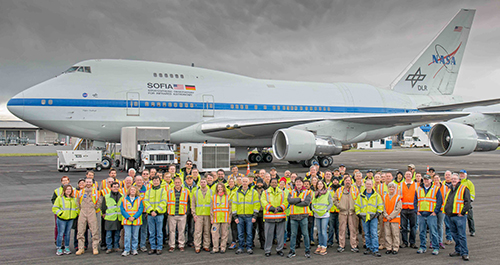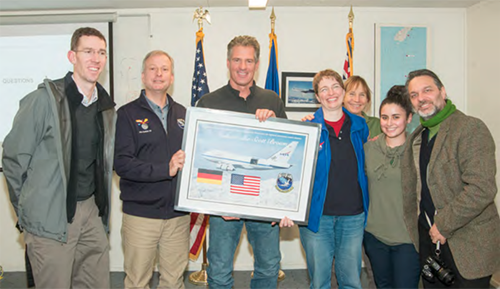September 2017
1. SOFIA Town Hall at the AAS meeting in Washington, D.C.
SOFIA science center staff will host the SOFIA Town Hall at the 231st AAS meeting in Washington, D.C., on Jan. 11, 2018, and we will announce new opportunities with the observatory.
SOFIA provides a unique capability for high-resolution spectroscopy at mid- to far-infrared wavelengths for studying the major cooling lines and continuum emissions of molecular clouds, proto-planetary disks, and accretion flows surrounding active galactic nuclei. Most recently, SOFIA has added a new capability to map magnetic fields in star forming regions and in the environment around the super-massive black hole at the center of the Milky Way Galaxy. SOFIA also provides critical synergies with current (e.g. Atacama Large Millimeter Array–ALMA, Atacama Pathfinder Experiment–APEX, Institute for Radio Astronomy in the Millimeter Range–IRAM, Hubble Space Telescope–HST) and upcoming observatories (e.g. James Webb Space Telescope–JWST, Wide-Field Infrared Survey Telescope–WFIRST, and the Origins Space Telescope–OST). This meeting will provide an update on the observatory’s current status, new instrument development, and opportunities for the astronomical community including a new set of key programs to maximize the science impact with associated funding.
The deadline for abstracts for the 2018 Jan AAS meeting is rapidly approaching (9 p.m. ET on Oct. 3). We encourage those of you with SOFIA results to present them at the meeting, and we will advertise your talks and posters at our SOFIA booth and Town Hall. Students or postdocs presenting their research based on SOFIA results, in particular as thesis presentations, may request to have their registration fees paid by the SOFIA project. Please send a note to sofia_help {at} sofia.usra.edu and include the title of your presentation.
2. Statistics of SOFIA Cycle 6 Call for Proposals Received
SOFIA Cycle 6 Call for Proposals closed on June 30, 2017; approximately 200 proposals were received. The proposals were subject to technical and feasibility reviews at the SOFIA Science Center in support of the independent peer review panels, which are under way. Recommendations of the U.S. and German peer review panels will be merged, and results of the Cycle 6 Proposal Call selection are to be announced sometime in October 2017.
3. SOFIA's Southern Hemisphere Deployment and Science Flights

Hello from New Zealand! Crew from the 2017 SOFIA deployment. Photo credit: Waynne Williams
SOFIA began its fourth deployment to the southern hemisphere on June 21, 2017. The observatory departed from its home base in Palmdale, California, and arrived at Christchurch International Airport, New Zealand, on June 23. This deployment duration was six weeks involving five instruments – two different configurations of the German Receiver for Astronomy at Terahertz Frequencies ( GREAT ), the Focal Plane Imager–Plus ( FPI+ ), the Far-Infrared Field Imaging Line Spectrometer ( FIFI-LS ), and Faint Object infraRed Camera for the SOFIA Telescope ( FORCAST ), and it was successfully concluded with the ferry flight home to Palmdale on August 13, 2017. The weather in New Zealand provided long, cold winter nights, which were ideal for astronomical observations. During this deployment, 19 science flights were completed, and a crew of some 125 scientists, mechanics, and technicians used the U.S. National Science Foundation's Antarctic Program facility at the Christchurch International Airport as their base of operations.
The GREAT instrument, a far-infrared heterodyne spectrometer (P.I. Rolf Guesten, Max Planck Institute for Radio Astronomy in Bonn, Germany) observed the Galactic center's Central Molecular zone, high velocity gas in the form of a jet in young stellar objects (to study dynamics of jets), and massive young stellar objects (to measure infall of high-mass star-forming regions). The targets included low-metallicity interstellar medium clouds in the Small Magellanic Cloud, and Asymptotic Giant Branch stars to study the carbon budget of the detached gas shell around the stars.
The FIFI-LS (P.I. Alfred Krabbe, University of Stuttgart, Germany) observing campaign included significant time on extra-galactic research: nearby luminous active galactic nuclei (AGN) stars (to study star formation, stellar populations and AGN feedback effects), nearby dwarf galaxies and infrared bright galaxies (to study the oxygen and nitrogen abundances) and starbursts in distant gas-rich galaxies. Also significant amounts of time were spent on observing the nearby, active star-forming region of 30 Doradus in the Large Magellanic Cloud and the center of the Milky Way (Sagittarius A and Sagittarius B2) to study star formation and the state of the surrounding interstellar medium.
The FORCAST instrument (P.I. Terry Herter, Cornell University, Ithaca, New York) observed well-known star-forming regions (to study the youngest stages of massive star formation, e.g. the Omega Nebula – M17, and the W51 cloud complex) and dusty red supergiant winds (to measure mass and age dependency). FORCAST also observed time variability of pre-transitional disks around young stellar objects, active galactic nuclei, supernova 1987A, and accretion by a white dwarf. FORCAST grism observations included young and luminous debris disks (to document and characterize the mineralogy evolution in the mid-IR region), the eruptive luminous blue variable star Eta Carinae (to measure changes in mass, composition, and grain properties), symbiotic stars (e.g. R Aquarii, to trace the enhanced binary activity), planetary nebula and ionized hydrogen (HII) regions (to understand the nebular abundance discrepancy).
On July 10, 2017 SOFIA flew through the predicted location of the shadow of the next New Horizon flyby object, 2014 MU69, arriving at the predicted location to within a mile and within a second of the predicted time.
Websites and podcast related to SOFIA activities during the deployment are also available.

We were pleased to have the United States Ambassador to New Zealand, Honorable Scott P. Brown and the New Zealand Minister of Transport, Honorable Simon Bridges, participate in a SOFIA science flight. The photo above shows Ambassador Brown receiving a signed lithograph with a flag that was flown on SOFIA. From left to right: Craig Halbmaier (U.S. Embassy political and economic officer in New Zealand), Bill Reach (SOFIA/USRA Deputy Director); Ambassador Brown; Kimberly Ennico Smith (NASA/SOFIA Project Scientist); Candy Green (Deputy Chief of Mission, U.S. Embassy in New Zealand); Alexia Bibertidou (CEO Girl Boss and STEM educator); and Dr. Jordan Alexander (senior lecturer, Auckland University of Technology, Institute for Radio Astronomy and Space Research). Photo Credit: Waynne Williams.
Please feel free to direct questions and comments to the SOFIA Science Center help desk: sofia_help {at} sofia.usra.edu.
Follow SOFIA on Facebook: @SOFIAtelescope